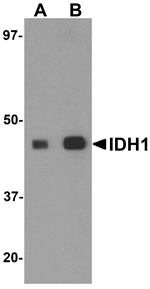Isocitrate dehydrogenases catalyze the oxidative decarboxylation of isocitrate to 2-oxoglutarate. These enzymes belong to two distinct subclasses, one of which utilizes NAD(+) as the electron acceptor and the other NADP(+). Two NADP(+)-dependent isocitrate dehydrogenases have been found as homodimer: IDH1 is predominantly cytosolic and peroxisomal and IDH2 is mitochondrial. The presence of IDH1 in peroxisomes suggests it may play a role in the regeneration of NADPH for intraperoxisomal reductions, such as the conversion of 2, 4-dienoyl-CoAs to 3-enoyl-CoAs, as well as in peroxisomal reactions that consume 2-oxoglutarate, namely the alpha-hydroxylation of phytanic acid. The cytoplasmic IDH1 serves a significant role in cytoplasmic NADPH production. Defects in IDH1 are involved in the development of glioma.

